Iraqi Kurdistan
Things to DO
Erbil
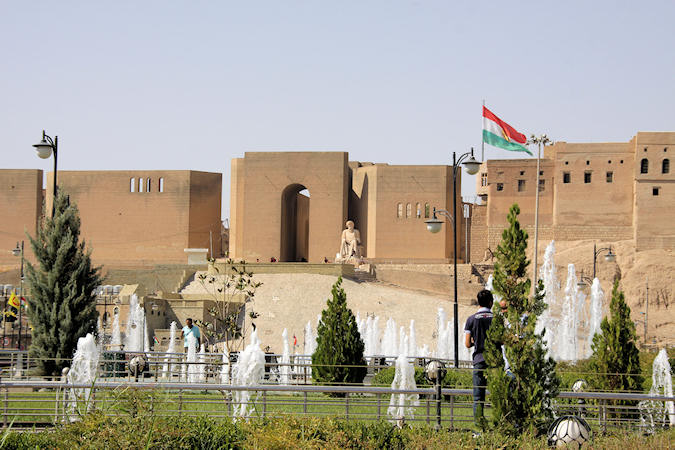 |
|||||
Erbil (Irbil; Kurdish: Hawler) is the capital of the Kurdish Regional Government and the largest city
in Iraqi Kurdistan. It is one of the oldest continuously inhabited cities in the world.
The Hurrians were the first to establish Urbilum and expand their rule to the rest of northern
Mesopotamia. The city has since been under the rule of many regional powers, including the Assyrians,
the Babylonians, Kurds under the rules of Persians, the Greeks, the Arabs, and
the Seljuk and Ottoman Turks.
Today, Erbil is where it’s all happening. It’s the fastest-growing city in Iraq, with dozens of glossy
shopping malls, amusement parks, five-star hotels, glass office blocks and a flash new airport.
Billboards advertise luxury Western-style homes in posh subdivisions with names such as ‘Dream City’ or
‘English Village’.
Erbil’s master plan even calls for championship golf courses, a wildlife safari park and a Grand Prix
racetrack.
Clearly Erbil thinks itself the new Dubai and with the energy on the streets and the money to back it all up,
who’s to say it’s not.
Citadel
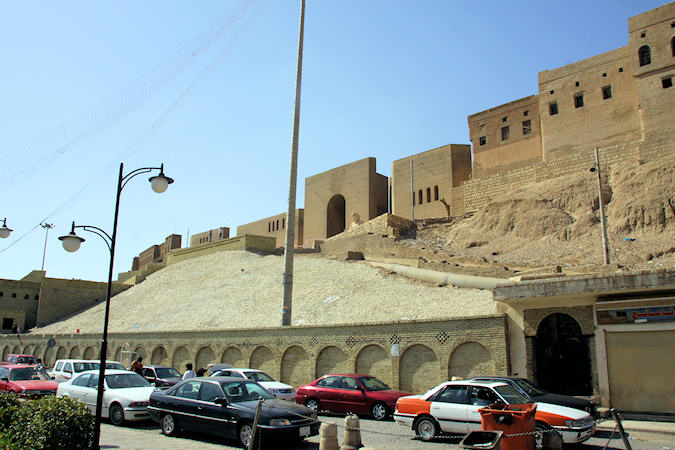 |
|||||
The Citadel Town of Erbil, is an impressive elevated settlement that has been inhabited continuously
for millennia. Although it's exact origins cannot be traced with certainty, there are strong archaeological
indications and finds, however, to indicate that it goes back to some 6.000 years.
The fortified town itself must have been present during to the Assyrian Period (1365-612 BC), or some
3.000 years ago.
The citadel town of Erbil occupies an elliptical-shaped mound about 30 meters high above the natural ground
level of the city below. Its long diameter is about 430 meters and its short diameter is about 340 meters.
Its overall area is slightly more than 10 hectares (102,000 square meters). It is surrounded by a steep
earthen mound in all directions which made it very difficult for any attacker to scale it. The town is largely
occupied by traditional courtyard houses reached through a labyrinth of narrow alleyways. The houses that
are built on the perimeter are contiguous and form a solid wall very similar to fortified citadels of medieval
times.
The recent decision to evict the inhabitants was taken only because the architectural heritage of the town was
in a real and serious danger. None of these inhabitants was an original owner and most of them were poor
migrants and squatters who came from surrounding villages. The lack of maintenance, haphazard rebuilding,
demolition, water seepage, and overcrowding, was causing a notable deterioration of its physical fabric.
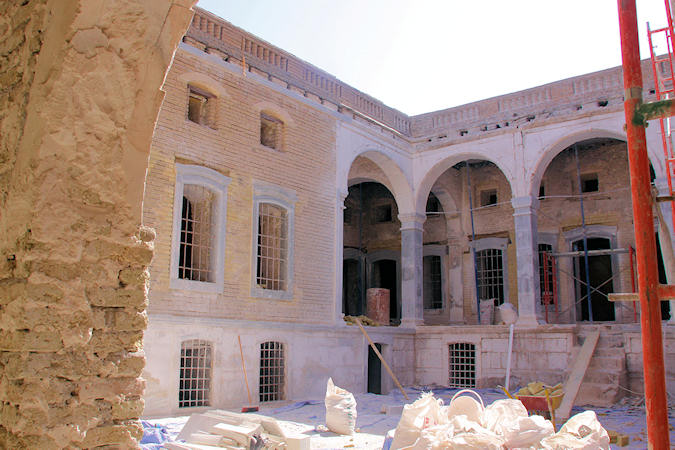 |
|||||
Immediate action was then taken by the KRG to establish a "High Commission for Erbil Citadel
Revitalization" or HCECR for short, to be in charge of the citadel. HCECR in collaboration with
UNESCO are preparing a detailed survey of the existing state of the citadel and a "Conservation and
Development Master Plan" in order to safeguard its remaining architectural and urban heritage and to revitalize
it once again. It is hoped that when this plan starts to be implemented life will, once again, begin to take roots.
This Master Plan will outline the future conservation and development strategies for the citadel house by
house and building by building. Obviously, many new functions, both cultural and social, would have to be
reintroduced. Museums, libraries, bookshops, shops, restaurants, cafes, artist studious, traditional crafts
workshops, as well as housing, will be provided.
Some of these activities will be housed in restored buildings and others would have to be accommodated in
newly designed buildings.
Kurdish Textile Museum
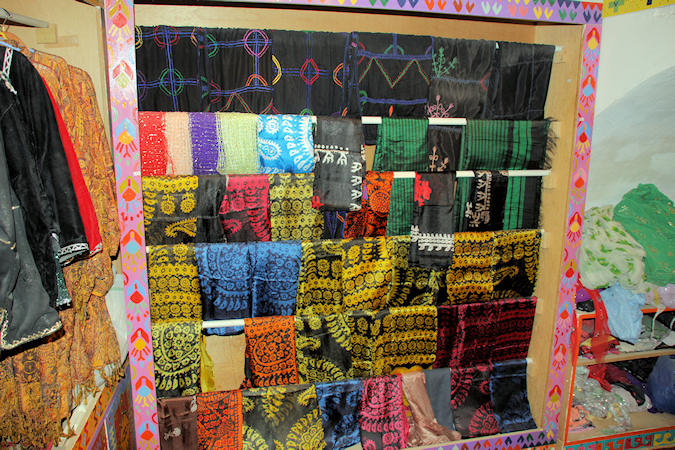 |
|||||
The Museum houses private selection owned by a set of Kurdish brothers displayed in a house in the Citadel.
Most rugs come from Iranian Kurdistan as there is no production here although an international NGO have
sponsored a small group of women who still know the craft.
Women of the Kurdish tribes learn to use the raw materials of wool and hair from their herds and natural
vegetable dyes from their environment. They are responsible for constructing the looms and weaving. Each
individual woven article reflects the talent, accuracy, and natural artistic ability of its weaver.,br>
It is, however, travelers and orientalists visiting and writing about Kurdistan who have drawn attention to
the beauty of the weavings. Kurdish rugs and carpets have now been displayed in different American and
European museums.
Don't forget to stop next door and visit the only real antique shop in Erbil, which have been rebuilt after
a burned down in November 2008.
Minare Park
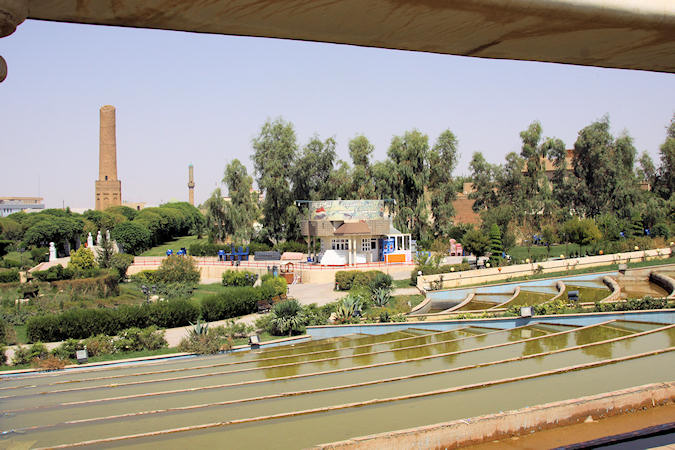 |
|||||
Without a doubt the most architectural of Erbil’s green spaces, Minare Park, close to the city
center, offers up an eclectic fare of circular terraces, Etruscan columns and cascading fountains. Lit up like
an urban wonderland on summer evenings, the park is a popular destination for the city’s youth and young
families taking in the cool evening air. Well-planted walkways and shaded groves provide a romantic back-drop
for promenading couples and a raised terrace cafe offers narguille (hookah pipes) and welcome
refreshments.
Tucked away in a quiet corner of the park is the Mudhafaria Minaret, also known among Kurds as
Choly Minaret. The minaret was built in 1190 by Muzaffar al-Din Abu Sa'eed al-Kawkaboori, the king of Arbil.
Excavations have uncovered the foundations of a large mosque to the southeast of the minaret, disproving the
previously held belief that the minaret was part of the madrasa built by the same donor.
The minaret is composed of a high octagonal base and a tall cylindrical shaft, with a balcony located between
the base and the shaft. It is built of baked bricks. The base is decorated with two tiers of niches with
pointed arches, two on each of the eight faces that are inscribed in rectangular frames.
Bazaar
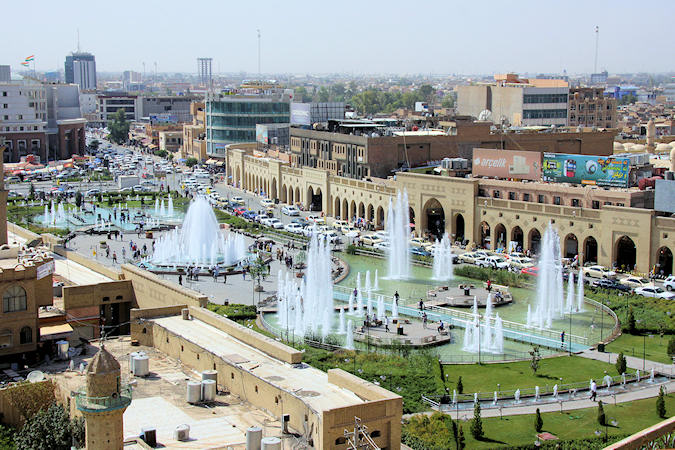 |
|||||
At the foot of the ancient citadel, the Qaysari Bazaar spreads out as far as the eye can see. The
first souk on this site appeared in the 13th century AD when the city began to spread beyond the confines of
the walled enclosure above.
Prepare to get lost in the covered labyrinth of alleyways that spider their way through a myriad of stalls
and stores selling everything from household appliances to gold.
There is heaps to buy, mainly from Turkey and China; so roam this magical bazaar for cheap bargains,
handmade products, gold shops, rug shops, tailors that will put together a typical Kurdish ‘suit’, stalls
selling Barzani scarfs, sandwich shops and even a shoemakers' quarter!
The Qaysari Bazaar offers a taste of city life that has changed little over the centuries and a unique
opportunity for an authentic cultural encounter.
Nineveh Plains
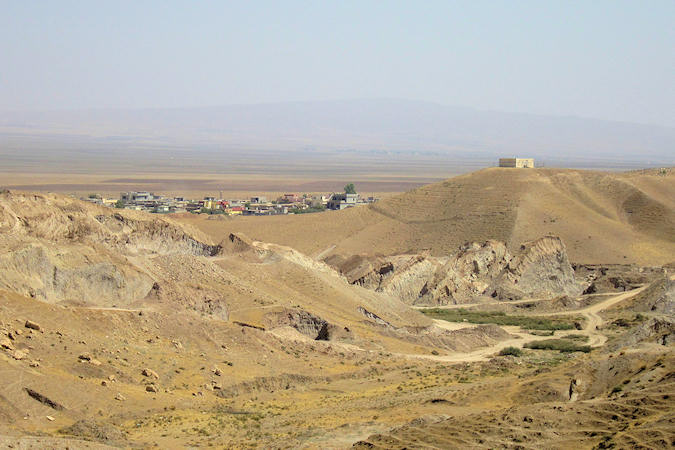 |
|||||
Nineveh Plain lies to the east, northeast of the city of Mosul in the Iraqi Ninawa Province.
Although the actual ancient city of Nineveh is to be found in the eastern part of Mosul, on the bank
of the Tigris river, the villages that are inhabited by minority religious groups that are non-Muslim lie to
the east.
Most of these inhabitants are Assyrian Christians.
Many Assyrians leaders are pressing for an autonomous region in Nineveh. The plan has not been taken seriously
by national Iraqi leaders, but has a strong proponent in Kurdistan Regional Government, which holds currently
the districts Shekan and Akra under control
The Nineveh Plain appears to hold under its rich agricultural lands an extension of the petroleum fields
tapped in 2006 by the Kurdish Regional Government in direct contract with foreign oil exploration companies.
Alqosh
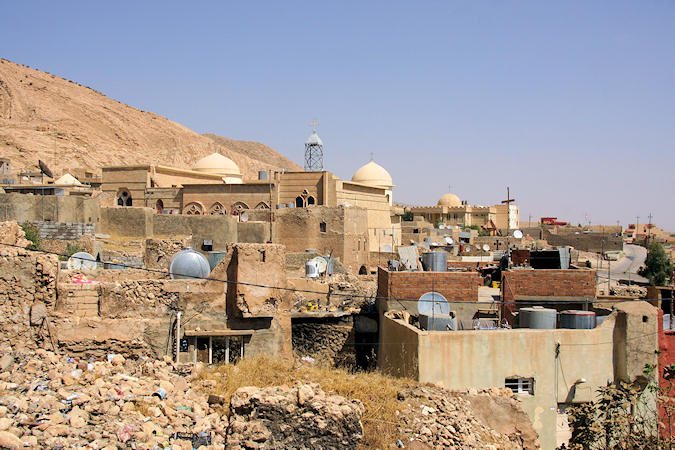 |
|||||
Alqosh, which sits a short way to the southeast of Dohuk and not all that far from the violently
contested city of Mosul, is in an area of great ethnic and religious variety.
The name Alqosh (or Elqosh) is derived from a Assyrian name Eil-Kushtu, where "Eil" means God and
"Kushtu" means righteousness or power. Therefore, Elqosh, or as casually pronounced Alqosh, means "The
God of Righteousness" or "The God of Power."
Alqosh traces its history back into the ancient Assyrian empire and perhaps even further back into history.
The earliest mentioning of Alqosh appears in Sennacherib's era 750 BC
The village itself is well worth taking time to explore. The old quarter is a squiggle of narrow streets and
silent alleyways in which it’s easy to spin back the wheels of time. Don’t miss the cemetery on the
outskirts of the village with it’s collection of tombs topped with impressive Christian crosses.
Since its establishment, Alqosh has played a major role of worship for early Assyrians and Jewish prisoners
who were brought by the Assyrians during the eight and ninth century B.C.
 |
|||||
With the spread of Christianity the Assyrians of the Nineveh plain (including Alqosh) were among the first people who accepted the message of Jesus Christ.
With the birth of the schism in the universal church, Alqosh became naturally part of what was known as the
Nestorian or Persian Church. It remained as such until the spread of Catholicism in the Mosul
plain.
Alqosh had acquired a special place with the arrival of monk Hurmiz, who built a monastery in A.D. 640
that took his name. This monastery (Rabban Hurmiz) was used later as the See for many Patriarchs of
the Church of the East from the fourteenth century to the middle of the twentieth century when the see
was moved to Baghdad.
Catholicism began to enter Alqosh around 1762 when Shamasha (Deacon) Hadbesha accepted Catholicism at
the hands of Patriarch Joseph IV in Amid (Diyar Bakir), in modern Turkey, and started propagating it upon his
return to Alqosh.
Nahum was a minor prophet who lived during the seventh century B.C. The Prophet Nahum prophesies
the ruin of the Assyrian city of Nineveh because of its iniquity, the destruction of the Israelite
kingdom, and the blasphemy of King Sennacherib against God. He preached in the area between 726-697 BC, and
was buried inside the synagogue of AlQosh
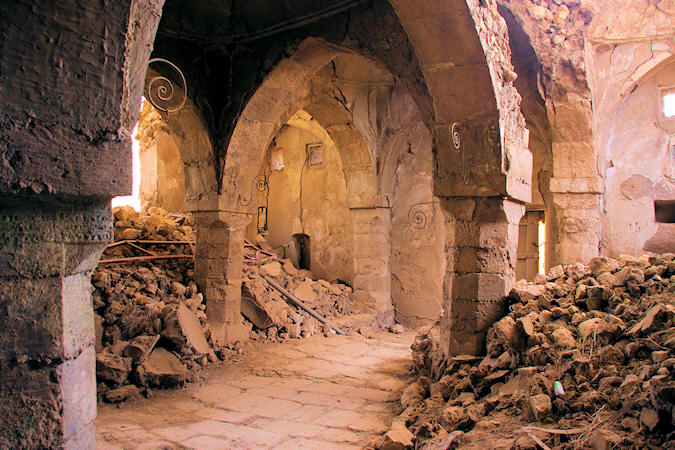 |
|||||
Alquosh was abandoned by its Jewish population in 1948, when they were expelled due to their religious
difference with the prevailing Muslims of the region.
Sami Jajouhana was asked to be the keeper of Nahum's tomb. He was handed the iron keys and an old
leather ledger by his Jewish friend who left al-Qosh in 1948. Jajouhana promised his dear friend to care for
the sacred site for Jews.
Beneath one of the few remaining standing synagogues in all of Iraq, Nahum's tomb is at risk. For over half
a century, few Jewish pilgrims have journeyed to the site. Nonetheless, Jajouhana keeps his promise to his
old friend, by recording the few who do tour the tomb or visit the synagogue and to care for their holy place.
The building is crumbling and in need of major repairs. Most of the roof’s supporting beams and some stone
walls have deteriorated. The Hebrew scripture is unmistakably visible on the interior walls—square,
precisely carved, unobtrusive and definitively Hebrew. All at risk to be forever lost except for this one
man on a mission to rebuild.